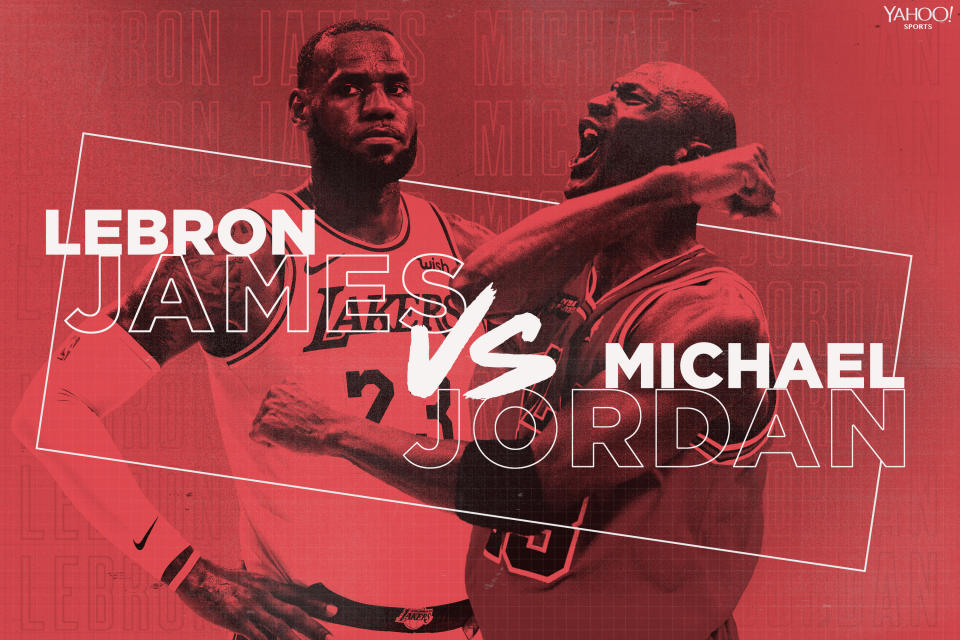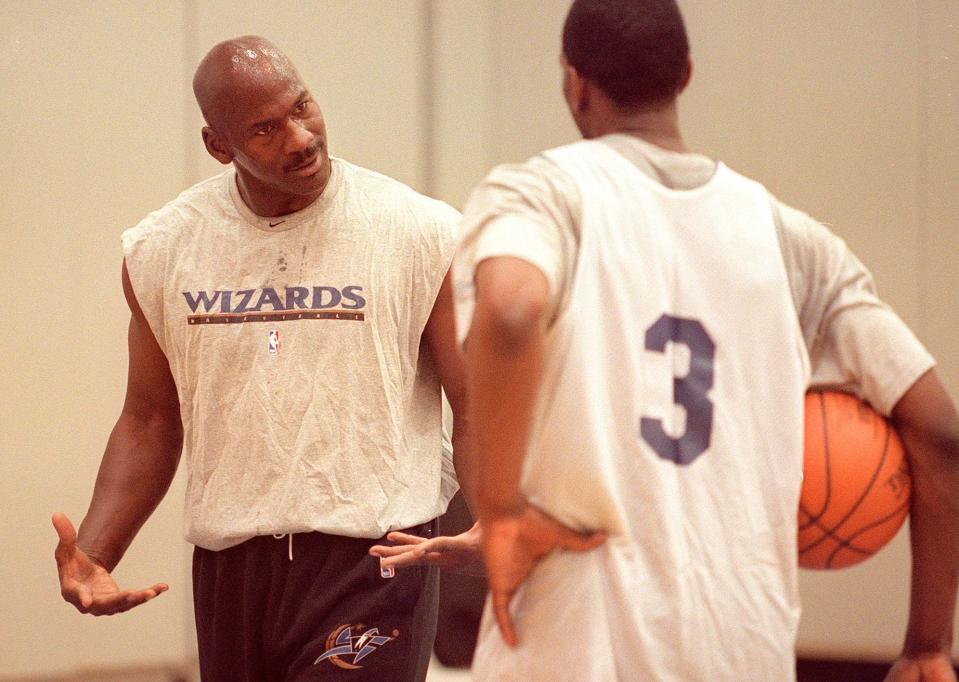The Jordan-LeBron Teammate Club: What's it like to play with the GOATs?

It is, in many ways, the quintessential hoophead trivia question: Can you name the four former NBA players who shared locker rooms with both Michael Jordan and LeBron James?
Scott Williams can. In fact, he’s used the stumper on several occasions to coax a free beer out of a friend. But he’s in the minority. An overwhelming minority. Because he’s a member of the club.
It’s an exclusive club that spans almost 25 years of basketball. The two players widely considered the greatest in NBA history did not overlap and never shared a court. They only dueled hypothetically via interviews or in video games. Two months after Jordan said goodbye to the league he conquered, James strode across a Madison Square Garden stage to formally begin his ascent.
[Yahoo Fantasy Basketball leagues are open: Sign up now for free]
Fifteen years later, that common-teammate club is no longer growing. The last of Jordan’s former teammates is now out of the league. But the debate of “Who’s better?” rages on. It divides NFL locker rooms and defines friendships. It’s both the scourge of and sustenance for NBA Twitter and TV shows, the inescapable comparison that looms even when left unsaid.
And few, if any, are more qualified to discuss it than those four common teammates.
Williams, who now owns a media and security company in Arizona, was a rookie with Jordan in Chicago, then a veteran with sophomore LeBron. Larry Hughes, who now runs a basketball academy in St. Louis, caught Jordan in Washington, then LeBron a few years later in Cleveland.
Jerry Stackhouse, now a Memphis Grizzlies assistant, and Brendan Haywood, now an analyst for NBA TV and Turner Sports, were also on Jordan’s final Wizards team. The former eventually crossed paths with LeBron in Miami. The latter’s final NBA season was LeBron’s first back in Cleveland.
They are not necessarily arbiters of the GOAT debate. After all, none went to battle with both icons in their respective primes. But each offers a unique window into greatness. And three of the four spoke with Yahoo Sports in advance of the 2018-19 season to delve into the traits and vibes that differentiate and distinguish the Jumpman and the King.
The Jordan practice tales
When the first of the four joined Jordan in Chicago in 1990, there were already stories. Not as many, nor were they as widespread. But they existed. Less than a year earlier, MJ had walloped Will Perdue’s face with a closed fist.
Still, Scott Williams arrived at training camp as an undrafted free agent expecting practices. “Grueling” practices, yes – two weeks of two-a-days, three hours per session, “banging” – but practices nonetheless. Instead, he got “wars.”
Jordan’s competitiveness and day-to-day intensity have become legend. Former teammates confirm all the tales. Every day, every drill. One-on-one close-out, two-on-two help and recover, fireman drill. Three-on-three, five-on-five, half-court shots. Card games. “Jordan approached everything as a competition,” Williams says.
Which meant everything was accompanied by chatter. And very little of it was friendly. Even toward the twilight of his career. “The trash-talking,” Hughes recalls. “The disrespect. … Those practices were unlike any other that I was a part of.”
Says Haywood: “He’s talking about how bad he would destroy you.”
Haywood remembers switching out on Jordan during a practice in Washington. “I took a couple steps back. Threes weren’t really his thing. … He pulled up immediately, just to shut me up, and hit the three. And then he was like, ‘Boy, you should know better, you grew up watching me. There’s nothing I can’t do on this court.’ ”
Williams uses the word “surprised.” Surprised, initially, that an MVP would go harder than anybody else on the practice floor. Williams’ next career stop would be Philadelphia. Sixers stars, he says, “wanted to save it for the game. … They’d ride the stationary bike on the side, talk trash while other guys did drills.”
But this was the same Jordan who, at 23, ripped Bulls management for limiting his workload coming off a broken foot. And who, at 38, four hours after the Wizards touched down in Washington at 3:30 a.m. following a road trip, was at the team facility working out.
“The only time he ever took a drill off, or maybe cut practices a little short, was when [former Bulls coach] Phil Jackson absolutely made him,” Williams says. “And he went to the sideline cussing.
“I never saw that again out of another player,” Williams says of Jordan’s unceasing drive. “Until, in my 15th year, I joined Cleveland.”
A ‘different type of superstar’
In the interim, Williams made his way around the NBA, to five other franchises — seven in total. “I played with a bunch of star players in the league who were very talented,” he says, but who “weren’t professional – I’mNotGonnaSayAnyNamesIverson. There was something about MJ and LeBron that, you could tell right away, this is a different type of superstar.”
Different from contemporaries, but also different from each other. James, Williams says, “wasn’t a killer the way Michael was. Michael wanted to rip the still-beating heart out your chest, and feed it to you. And LeBron just didn’t have that. He had an intensity and desire to win, but more of an intensity and desire to win as long as the team won. … It wasn’t that killer instinct.”
LeBron had watched Jordan growing up. He met Jordan before his junior year of high school. He had idolized him. But emulation was never excessive, nor exceedingly apparent. Because LeBron watched others, too. He loved Iverson. And he even studied those well before his time. He would ask Williams about everyone from Magic and Bird to James Donaldson. “He wanted to know about James Worthy … guys he didn’t necessarily see as a youth, but he went back and watched the classics, and got on YouTube.”
LeBron’s basketball addiction is well-documented. He’s obsessed. He’ll watch everything, from WNBA thrillers to Division II college slogs. He’s always learning.
Williams recalls James broadening his now-vast internal library even as a teenager, in the wee hours of the morning, as most veterans snoozed. Plane rides, for LeBron, were film sessions. Cavs staffers would prepare edited clips. James would get ahead on Cleveland’s next opponent, or deconstruct his own game, occasionally asking questions of nearby teammates or even getting up to confer with a coach.
Jordan, back in the day, didn’t have the requisite technology to do the same. But, Haywood says, “In that way, they’re identical. Both of these guys understood the game, studied the game, loved the game, paid attention to the scouting report. They could tell you everybody’s tendencies, their weaknesses, their strengths. And they expected their teammates to know them as well.”
The difference between the two is what Haywood deems Jordan’s “cutthroatness.” Each had a zeal unparalleled in his own era. They just took different forms.
“LeBron wants to win as well,” Haywood assures. “But he might come out one day and be passive, because he’s trying to get other guys involved. … He’s trying to be more of a game manager, a secondary GM within the team.”

A different type of teammate
Williams’ first year in Chicago was also Dennis Hopson’s first. Hopson, at the time, was a blooming 25-year-old two-guard, a 16-point-per-game scorer the year before in New Jersey. His reward was a trade to the Bulls – and daily duels with MJ.
Less than two years later, he was out of the league.
“One of the saddest things I ever saw during my professional career was the way [Jordan] went at Dennis Hopson every day in practice,” Williams says. “He got physical. He got mental with Dennis to the point where [Hopson was] so physically and mentally busted down, having to try to stop MJ every day in practice, that he was a shell of a player, and they traded him off to Sacramento.
“And that wasn’t a reflection of how MJ treated people. It was just a reflection of his intensity. He only had one gear.”
A decade later in Washington, Jordan still wasn’t relenting. He’d go at Bryon Russell, over whom he hit The Last Shot, non-stop. Says Hughes: “Non-stop in practice, non-stop in the locker room, non-stop on the bus, the plane.”
Then there was Kwame Brown. “M had Kwame Brown running up a wall,” Hughes says. Brown has denied reports that Jordan brought him to tears, in part with homophobic slurs. The point, though, is that Jordan was ruthless.
And that, Hughes says, is a difference: “MJ is more direct … Bron is more forgiving.” James, Haywood says, would use positive reinforcement. He’d give the rousing motivational speech.
Haywood believes LeBron learned the importance of team camaraderie and inclusiveness from Pat Riley in Miami. His first season back in Northeast Ohio, James rented out a mansion for a team dinner on a preseason trip to Brazil. He organized movie nights. He took teammates to Kevin Durant’s restaurant on a trip to Oklahoma City.
He’d spread material wealth, too. The release of a Beats by Dre commercial featuring LeBron would be accompanied by brand new headphones in teammates’ lockers. Same went for new Nikes. And if LeBron starred in a Samsung commercial? A distributor would be handing out phones at the team hotel the following day.
“That, to me, is probably the biggest difference,” Haywood says. “LeBron wants to build that relationship. MJ, he’ll have that relationship, but if it’s not there, he don’t care. As long as you win games.”
So who’s the GOAT?
All three acknowledge the difficulty of quantitative comparison. (And Stackhouse surely would too; he was unavailable for an interview while preparing for the season.) But all three have an opinion. The same opinion. The greatest of all time?
“Right now,” says Haywood, “it’s MJ.”
“When you’re talking about greatness,” he continues, “MJ is the best combination of stats, winning, and championship moments. Certain things go beyond statistics.”
Hughes and Williams decry the occasional reduction of the debate to statistics as well. LeBron’s numbers, Hughes concedes, will “blow people out of the water. … But it’s good to understand when you play with those guys, at that point in time, what was the vibe?”
Says Williams: “I’ve never been a stats guy. Don’t start talking stats with me. That’s for all the sabermetric knuckleheads.”
Williams sides with Jordan “because of the killer instinct that he had.” Because of the “it” factor. And Hughes completes the trifecta.
“It’s MJ,” he says. “It’s real easy for me. Bron is great, and whenever I talk to people, I say, MJ is the Jumpman. Then we got Bron right there holding onto the shoe. He’s right in the ballpark. But MJ is the guy.”
More from Yahoo Sports:
• 2003 rape allegations cost Kobe spot on film festival jury
• Controversial call wipes out Astros home run
• NFL owners take a knee in waning anthem controversy
• Dan Wetzel: Gymnastics scandal secrets may finally go public
– – – – – – –
Henry Bushnell is a features writer for Yahoo Sports. Have a tip? Question? Comment? Email him at henrydbushnell@gmail.com, or follow him on Twitter @HenryBushnell, and on Facebook.

